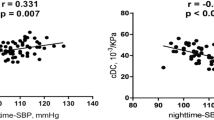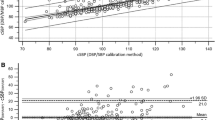Abstract
Aim
The aim was to analyze and compare the associations between body mass index (BMI) and structural and functional cardiovascular variables measured in children and adolescents.
Methods
609 healthy subjects (mean age/range 12/4–18 years, 45% females) were studied. Subjects’ BMI and the corresponding z-scores (z-BMI) were determined. Cardiovascular measurements: peripheral and aortic blood pressure (BP), aortic wave-derived parameters, common carotid, femoral and brachial artery diameters and stiffness, carotid intima–media thickness, carotid-radial and carotid-femoral pulse wave velocity (crPWV, cfPWV) and cfPWV/crPWV ratio. Cardiovascular data were standardized (z-scores) using equations (fractional polynomials) obtained from a sub-group (reference population, n = 241) non-exposed to cardiovascular risk factors (CVRFs). Simple and multiple regression models were obtained for the associations between cardiovascular z-scores and z-BMI and/or z-BMI, age, sex and CVRFs.
Results
z-BMI was associated with standardized cardiovascular variables, regardless of age, sex and CVRFs. BP (peripheral rather than aortic) was the variable with the greatest variations associated with z-BMI. Systolic (SBP) and pulse pressure (PP; in that order) were the variables with the highest variations associated with z-BMI. Carotid, but not femoral or brachial stiffness showed BP-dependent variations associated with z-BMI. Arterial diameters were associated with z-BMI, without differences among arteries.
Conclusion
In children and adolescents, z-BMI was gradually and positively associated with haemodynamic (peripheral and central BP) and vascular parameters (structural and functional) with independence of age, sex and other CVRFs (Dyslipidemia, Hypertension, Smoke, Diabetes). There were differences in the associations depending on the arteries studied and on whether central or peripheral haemodynamic parameters were analyzed.

Similar content being viewed by others
References
Mikola H, Pahkala K, Niinikoski H, Rönnemaa T, Viikari JSA, Jula A, Juonala M, Raitakari OT. Cardiometabolic determinants of carotid and aortic distensibility from childhood to early adulthood. Hypertension. 2017;70(2):452–60.
Sardinha LB, Santos DA, Silva AM, Grøntved A, Andersen LB, Ekelund U. A comparison between BMI, waist circumference, and waist-to-height ratio for identifying cardio-metabolic risk in children and adolescents. PLoS One. 2016;11(2):e0149351.
Zócalo Y, Curcio S, García-Espinosa V, Chiesa P, Giachetto G, Bia D. Comparative analysis of arterial parameters variations associated with inter-individual variations in peripheral and aortic blood pressure: cross-sectional study in healthy subjects aged 2–84 years. High Blood Press Cardiovasc Prev. 2017;24(4):437–51.
García-Espinosa V, Curcio S, Marotta M, Castro JM, Arana M, Peluso G, Chiesa P, Giachetto G, Bia D, Zócalo Y. Changes in central aortic pressure levels, wave components and determinants associated with high peripheral blood pressure states in childhood: analysis of hypertensive phenotype. Pediatr Cardiol. 2016;37(7):1340–50.
Expert Panel on Integrated Guidelines for Cardiovascular Health, and Risk Reduction in Children and Adolescents, National Heart, Lung, and Blood Institute. Expert panel on integrated guidelines for cardiovascular health and risk reduction in children and adolescents: summary report. Pediatrics. 2011;128(S5):S213–56.
Lurbe E, Agabiti-Rosei E, Cruickshank JK, Dominiczak A, Erdine S, Hirth A, Invitti C, Litwin M, Mancia G, Pall D, Rascher W, Redon J, Schaefer F, Seeman T, Sinha M, Stabouli S, Webb NJ, Wühl E, Zanchetti A. 2016 European Society of Hypertension guidelines for the management of high blood pressure in children and adolescents. J Hypertens. 2016;34(10):1887–920.
WHO Multicentre Growth Reference Study Group. WHO child growth standard based on length/height, weight, and age. Acta Paediatr. 2006;2006(450):76–85.
Armentano RL, Barra JG, Santana DB, Pessana FM, Graf S, Craiem D, Brandani LM, Baglivo HP, Sanchez RA. Smart damping modulation of carotid wall energetics in human hypertension: effects of angiotensin-converting enzyme inhibition. Hypertension. 2006;47(3):384–90.
Field A. Discovering statistics using IBM-SPSS statistics. 4th ed. London: SAGE-Publications Ltd; 2013.
Bellera CA, Hanley JA. A method is presented to plan the required sample size when estimating regression-based reference limits. J Clin Epidemiol. 2007;60(6):610–5.
Castro JM, García-Espinosa V, Curcio S, Arana M, Chiesa P, Giachetto G, Zócalo Y, Bia D. childhood obesity associates haemodynamic and vascular changes that result in increased central aortic pressure with augmented incident and reflected wave components, without changes in peripheral amplification. Int J Vasc Med. 2016;2016:3129304.
Charakida M, Jones A, Falaschetti E, Khan T, Finer N, Sattar N, Hingorani A, Lawlor DA, Smith GD, Deanfield JE. Childhood obesity and vascular phenotypes: a population study. J Am Coll Cardiol. 2012;60(25):2643–50.
Cote AT, Harris KC, Panagiotopoulos C, Sandor GG, Devlin AM. Childhood obesity and cardiovascular dysfunction. J Am Coll Cardiol. 2013;62(15):1309–19.
Iannuzzi A, Licenziati MR, Acampora C, Salvatore V, Auriemma L, Romano ML, Panico S, Rubba P, Trevisan M. Increased carotid intima–media thickness and stiffness in obese children. Diabetes Care. 2004;27(10):2506–8.
Atabek ME, Pirgon O, Kivrak AS. Evidence for association between insulin resistance and premature carotid atherosclerosis in childhood obesity. Pediatr Res. 2007;61(3):345–9.
Ayer JG, Harmer JA, Nakhla S, Xuan W, Ng MK, Raitakari OT, Marks GB, Celermajer DS. HDL-cholesterol, blood pressure, and asymmetric dimethylarginine are significantly associated with arterial wall thickness in children. Arterioscler Thromb Vasc Biol. 2009;29(6):943–9.
Verçoza AM, Baldisserotto M, de Los Santos CA, Poli-de-Figueiredo CE, d’Avila DO. Cardiovascular risk factors and carotid intima–media thickness in asymptomatic children. Pediatr Cardiol. 2009;30(8):1055–60.
Gao Z, Khoury PR, McCoy CE, Shah AS, Kimball TR, Dolan LM, Urbina EM. Adiposity has no direct effect on carotid intima–media thickness in adolescents and young adults: use of structural equation modeling to elucidate indirect & direct pathways. Atherosclerosis. 2016;246:29–35.
Simşek E, Balta H, Balta Z, Dallar Y. Childhood obesity-related cardiovascular risk factors and carotid intima–media thickness. Turk J Pediatr. 2010;52(6):602–11.
Reinehr T, Kiess W, de Sousa G, Stoffel-Wagner B, Wunsch R. Intima media thickness in childhood obesity: relations to inflammatory marker, glucose metabolism, and blood pressure. Metabolism. 2006;55(1):113–8.
Whincup PH, Gilg JA, Donald AE, Katterhorn M, Oliver C, Cook DG, Deanfield JE. Arterial distensibility in adolescents: the influence of adiposity, the metabolic syndrome, and classic risk factors. Circulation. 2005;112:1789–97.
Urbina EM, Kimball TR, McCoy CE, Khoury PR, Daniels SR, Dolan LM. Youth with obesity and obesity-related type 2 diabetes mellitus demonstrate abnormalities in carotid structure and function. Circulation. 2009;119(22):2913–9.
Chalmers LJ, Copeland KC, Hester CN, Fields DA, Gardner AW. Paradoxical increase in arterial compliance in obese pubertal children. Angiology. 2011;62(7):565–70.
Dangardt F, Osika W, Volkmann R, Gan LM, Friberg P. Obese children show increased intimal wall thickness and decreased pulse wave velocity. Clin Physiol Funct Imaging. 2008;28:287–93.
Hvidt KN, Olsen MH, Holm JC, Ibsen H. Obese children and adolescents have elevated nighttime blood pressure independent of insulin resistance and arterial stiffness. Am J Hypertens. 2014;27(11):1408–15.
Lurbe E, Torro I, Garcia-Vicent C, Alvarez J, Fernández-Fornoso JA, Redon J. Blood pressure and obesity exert independent influences on pulse wave velocity in youth. Hypertension. 2012;60(2):550–5.
Silva AB, Capingana DP, Magalhães P, Molina Mdel C, Baldo MP, Mill JG. Predictors and reference values of pulse wave velocity in prepubertal angolan children. J Clin Hypertens (Greenwich). 2016;18(8):725–32.
Urbina EM, Kimball TR, Khoury PR, Daniels SR, Dolan LM. Increased arterial stiffness is found in adolescents with obesity or obesity-related type 2 diabetes mellitus. J Hypertens. 2010;28(8):1692–8.
Author information
Authors and Affiliations
Corresponding author
Ethics declarations
Funding
This study was funded by the Agencia Nacional de Investigación e Innovación, Espacio Interdisciplinario and Comisión Sectorial de Investigación Científica of the Republic University, Uruguay. Additionally, was supported by extrabudgetary funds generated by CUiiDARTE-Centre. None of these organizations influenced the study design or collection, analysis, and interpretation of data; the writing of the report; or the decision to submit the manuscript for publication.
Conflict of Interest
Victoria Garcia-Espinosa declares she has no conflict of interest. Daniel Bia declares he has no conflict of interest. Juan Castro declares he has no conflict of interest. Agustina Zinoveev declares she has no conflict of interest. Mariana Marin declares she has no conflict of interest. Gustavo Giachetto declares he has no conflict of interest. Pedro Chiesa, declares he has no conflict of interest. Yanina Zócalo declares she has no conflict of interest.
Ethical Approval
All procedures performed in studies involving human participants were in accordance with ethical standards of the institutional and national research committee and with the 1964 Helsinki declaration and its later amendments or comparable ethical standards.
Informed Consent
Informed consent was obtained from all individual (or guardians).
Electronic supplementary material
Below is the link to the electronic supplementary material.
Rights and permissions
About this article
Cite this article
Garcia-Espinosa, V., Bia, D., Castro, J. et al. Peripheral and Central Aortic Pressure, Wave-Derived Reflection Parameters, Local and Regional Arterial Stiffness and Structural Parameters in Children and Adolescents: Impact of Body Mass Index Variations. High Blood Press Cardiovasc Prev 25, 267–280 (2018). https://doi.org/10.1007/s40292-018-0264-1
Received:
Accepted:
Published:
Issue Date:
DOI: https://doi.org/10.1007/s40292-018-0264-1




